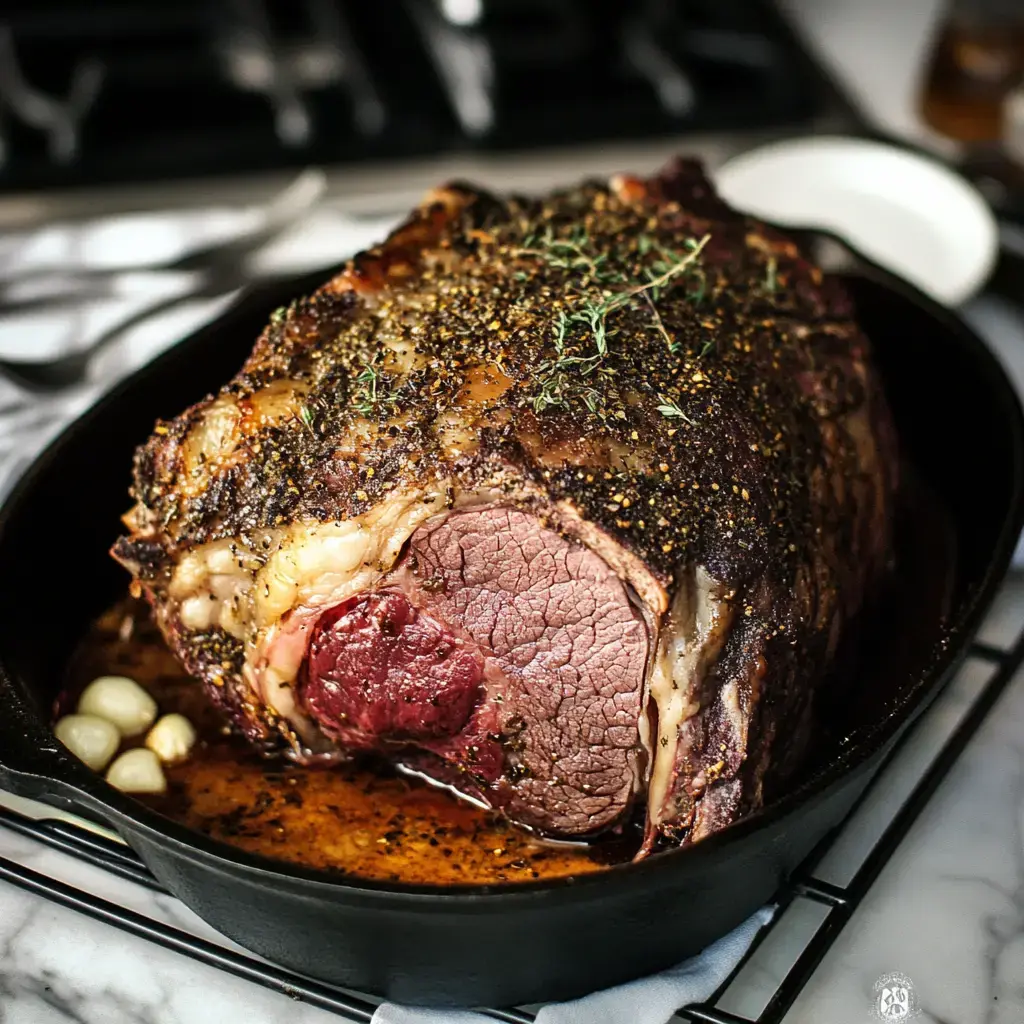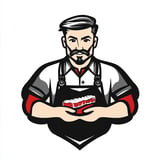 Pin it
Pin it
Want a knockout prime rib? This guide shows you exactly how to nail it every time. We'll cover all the bases - from cooking times to techniques that'll give you that mouth-watering crust with herbs and garlic. It's way easier than you think to get restaurant-quality results right in your kitchen.
Reasons To Make This Stunning Rib Roast
Don't let cooking a rib roast intimidate you - our straightforward approach makes it super easy. We've figured out all the timing so you won't have to guess. Whether you go for bone-in or boneless, this method works perfectly every time. Why drop hundreds at a steakhouse when you can create this impressive meal at home for your family and friends?
What You'll Need For This Delicious Roast
- Prime Rib: Choose bone-in for maximum flavor in your roast
- Sea Salt: Brings out the natural taste of the meat
- Fresh Black Pepper: Adds that classic spicy kick
- Fresh Rosemary: Gives an aromatic pine-like flavor
- Fresh Thyme: Adds subtle earthy notes to your beef
- Garlic: Creates a deep savory base
- Olive Oil: Helps your seasonings stick while roasting
- Horseradish: Adds a zingy kick if you want it
How To Prepare Your Rib Roast
- Temperature Matters:
- Let your meat sit out until it reaches room temp. This helps everything cook evenly throughout.
- Heat Your Oven:
- Start with a screaming hot 500°F oven for that perfect outer crust.
- Mix Your Flavors:
- Combine all those herbs and spices thoroughly for an even coating.
- Position It Right:
- Make sure your roast sits properly in the pan so heat can circulate around it.
- Blast It First:
- Give it 15 minutes at high heat to lock in those juices and create that amazing crust.
- Take It Slow:
- Turn down to 325°F and let it gently finish cooking to perfection.
- Don't Rush:
- Letting your meat rest isn't optional - it's essential for keeping all those juices inside.
- Slice It Properly:
- Cut against the grain for the most tender bites possible.
 Pin it
Pin it
Selecting Your Perfect Rib Cut
The meat you pick makes a huge difference in your final dish. While this approach works for both boneless and bone-in cuts, most fans agree keeping those bones during cooking adds tons of flavor. Many pros suggest cooking with the bones on, then removing them before you serve. Your local butcher can help prep this cut just right for your special meal.
Getting The Timing Just Right
Timing can make or break your roast. Start with that hot oven, then drop the temp down for the slow-cooking magic. For a perfect medium-rare, you'll want about 13-14 minutes per pound at 325°F. Don't try to eyeball it - grabbing a meat thermometer is the only way to be totally sure you've got it right.
Creating Flavor Magic
Your seasoning blend is what transforms an ordinary roast into something unforgettable. The mix of fresh herbs and garlic creates this amazing crust that'll have everyone asking for seconds. For the best results, don't rush this part - really work those seasonings in and give them time to meld with the meat before it hits the oven.
 Pin it
Pin it
Why You Can't Skip The Rest
That waiting period after cooking isn't just a suggestion - it's absolutely crucial. Once your roast comes out of the oven, it needs about 30 minutes under foil to finish its magic. This waiting time lets all those flavorful juices redistribute throughout the meat instead of spilling out when you cut into it too soon.
Presenting Your Masterpiece
The way you slice and serve your roast puts the finishing touch on all your hard work. This showstopper deserves some thought about sides too - crispy potatoes and warm rolls make perfect partners. Whether it's for a holiday gathering or just making Sunday dinner extra special, taking care with how you present your creation makes all the difference.
Frequently Asked Questions
- → What’s the resting time for cooked meat?
At least 30 minutes is a good rule of thumb. It helps keep all those delicious juices locked in. Avoid cutting into it right away. A loose foil wrap works great while it rests. It’ll be worth the wait!
- → Should I use fresh or dried herbs?
Fresh herbs bring out the best flavor. Dried herbs are fine, though, especially in a pinch. A mix can even work well. Remember to use smaller amounts of dried herbs since they’re more concentrated. Fresh is unbeatable if you can get them!
- → Is it better with the bones left in?
Both options are totally fine. If you leave the bones in, they’ll add flavor but might increase cook time. Always monitor the temperature closely. And hey, ask your butcher to tie it up nicely if you leave the bones in.
- → How do I get it slightly pink in the center?
Heat until the internal temperature hits about 130°F (54°C). Let it rest—it’ll rise slightly while resting. Using a meat thermometer is key here. That pink center equals tender perfection. Don’t let it go over 140°F (60°C).
- → Can I pair it with a spicy sauce?
Sure! A tangy white sauce works beautifully. Mustard’s another classic favorite. Prepare your sauce ahead of time and keep it chilled. Serve alongside the hot roast. No sauce? That’s fine too, the meat can shine on its own!
- → What if it browns too much on top?
Cover it loosely with foil if you find it browning too fast. Lower the heat a little or shift it farther from the top of the oven. Keep an eye on it more closely. It might need less cooking time in this case.
- → How do I take the roast elsewhere?
Keep the roast whole and wrap it snugly. Wait until you’re at your destination to carve it if possible. Grab a trusty knife, pack the sauce chilled, and bring along some extra sides just in case!
- → How can I cook it faster?
Go with a smaller cut of meat for quicker results. Let it come to room temperature before cooking, and start with high heat to speed up that initial browning. Don’t forget to rest it well afterward. Check internal temperatures frequently!
- → What should I do with a bigger roast?
Keep a quality meat thermometer handy. A larger cut needs more time, so check the internal temperature often. Rotate the pan halfway through cooking, and keep an eye on the ends—they might cook quicker than the center.
- → How do I add even bolder flavors?
Kick things up with extra garlic or experiment with different herbs. Rub the meat the night before, letting the seasonings really soak in. A sprinkle of salt can do wonders. Some folks even brush it with wine while roasting.
- → What if it turns out tough?
Let it sit at room temperature before cooking, and keep the heat from getting too high. Check the internal temperature carefully. Give it plenty of resting time post-cooking. If it’s still not right, consider upgrading to a better cut.
- → How do I know the right amount to make?
Plan for about two people per rib. Leftovers are always handy—they’re amazing served cold. Slice extras and store them in the freezer if needed. They’ll keep well in the fridge for a couple of days and make great sandwich fillings!
Conclusion
Craving more? Try a juicy lamb with herbs or prepare a tender beef filet. Both are perfect for your next event.
